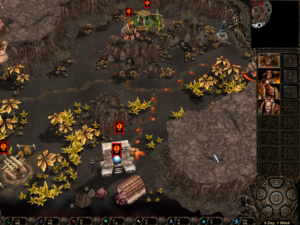Etherlords: Graphics
 The use of 3D graphics and animation in Etherlords is worth commenting on, because it illustrates some points about the use of these things in general.
The use of 3D graphics and animation in Etherlords is worth commenting on, because it illustrates some points about the use of these things in general.
For one thing, the gameplay requires a mere fraction of what the game does with graphics. Map mode requires a map, but all we really need is a fairly abstract 2D chart. Instead, we have a rotatable, zoomable perspective model of the gameworld, with buildings and the like, most of which are animated. Combat mode requires some way to identify specific creatures for targeted effects, and having all the creatures visible graphically is a reasonable way to do this. But this does not mean that the creatures need to be 3D models, and have movement and attack animations (and, in some cases, special-action animations as well), or that the camera has to dynamically switch around to the most dramatically appropriate position from time to time. Furthermore, I’d bet that if the game were written today, it wouldn’t use 3D graphics at all. 3D might have been a necessity for any game that wanted to be taken seriously in the marketplace of 2001, but I think we’ve more or less gotten over that, thanks to the casual games explosion. I wouldn’t say that Etherlords actually looks retro yet, the way that mid-90’s FMV titles do, but it’s probably only a matter of time.
So, from a certain point of view, the graphical frippery is unnecessary. The animations in combat mode in particular remind me of Battle Chess, or the Summon animations in the Final Fantasy games, in that they don’t affect the gameplay except by slowing it down. Etherlords is at least sensitive to the fact that some players will not want this, and allows you to disable combat animation. But you have to figure that not many people will do this. The person who plays Etherlords does so at least in part because they like watching the graphics. And I have no quibble with that — heck, sometimes I go to a cinema and pay to watch computer graphics that aren’t even interactive at all.
However, given that this is a game and not just a graphics demo, one can hope that the graphics wouldn’t actively interfere with gameplay — and one can be disappointed. Some inaccessable regions in map mode are represented as plateaux, and are tall enough to obscure the things behind them. Smaller bonus items can be rendered completely invisible this way until you rotate the view. And in combat mode, I’ve had the unpleasant experience of having the bounding box of a creature I wanted to click on be completely engulfed by that of my hero. When this happens, the player’s only recourse is to switch to manual camera control and shift to a better POV. It’s nice that you’re able to do that, but it’s a workaround for an unnecessary problem.
Still, I have to say that the graphics are an overall positive part of the experience here, because when I came back from my week away and started playing this again, something in my brain said “Yay! 3D graphics!” It isn’t the most sophisticated application of 3D graphics, of course, but I think that adds to the effect — the obviously handcrafted polygons, in that cusp between the slick and the amateurish, draw my attention to their artfulness, rather than simply looking like the things they represent.
 Comments(0)
Comments(0)